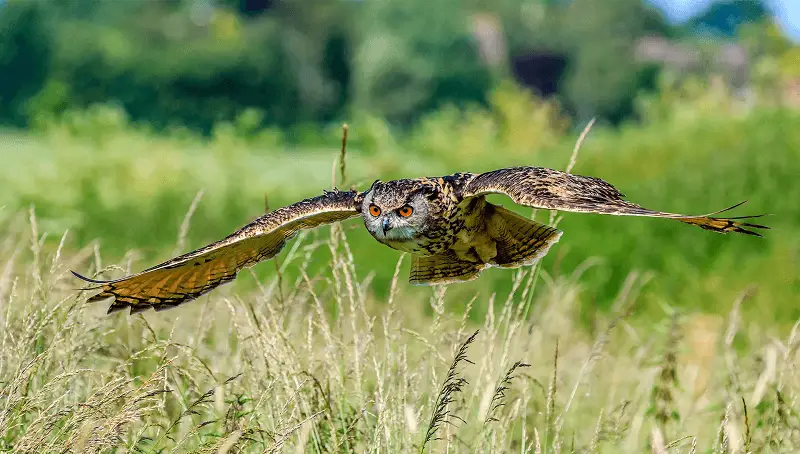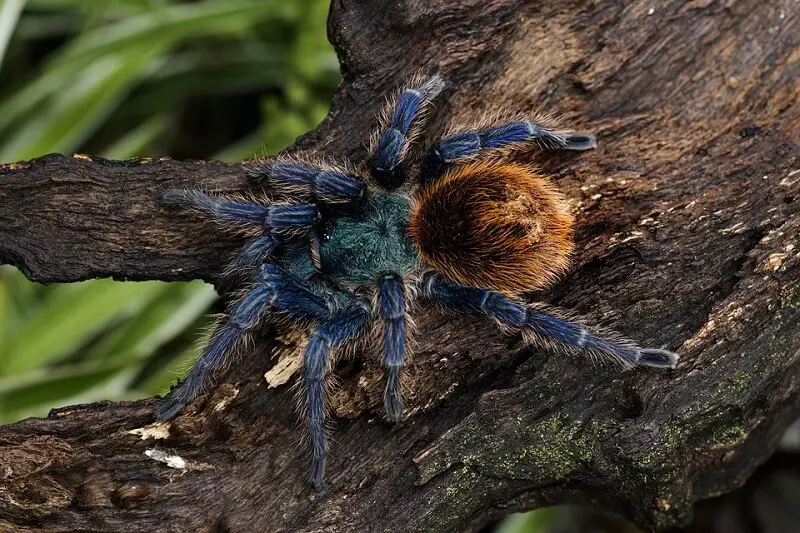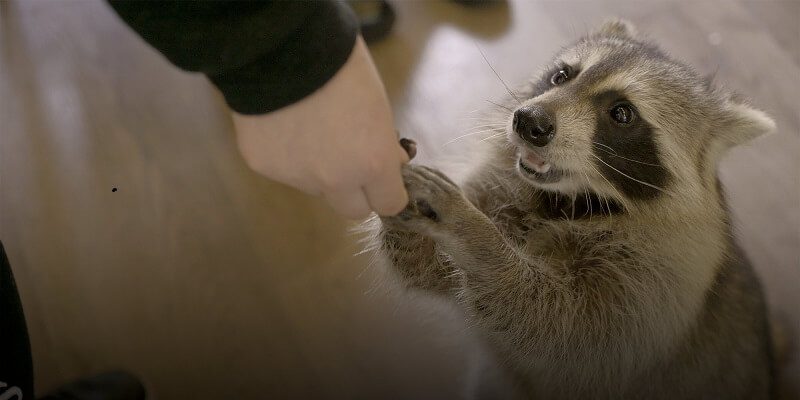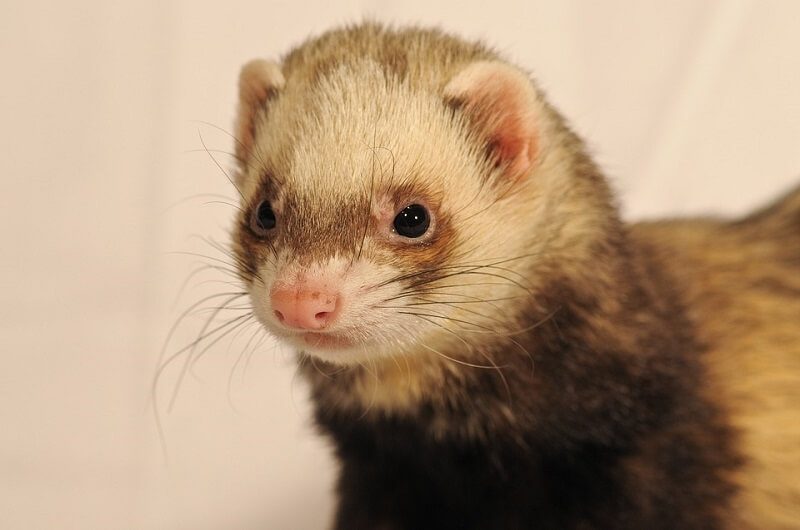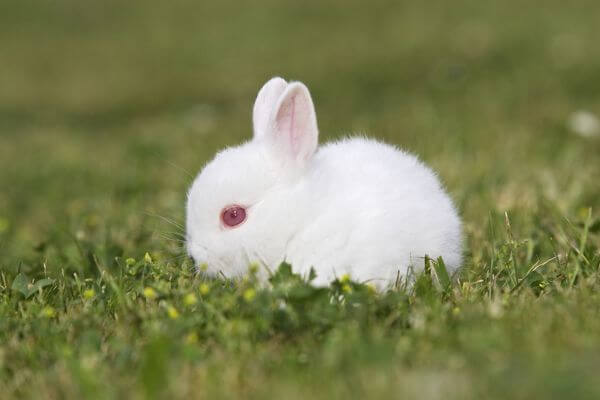Owls differ in color, appearance, or size, but they all can rotate their heads 270 degrees. All owl species are carnivores except for the Elf owl which feeds on seeds or fruits.
The largest species of owls can hunt mammals such as wolf cubs, foxes, or small deer. Owls hunt so well that some species catch their prey without being heard. The most common one is the Barn owl, which can hunt up to 1000 mice a year. Farmers appreciate it because it reduces the number of mice that damage crops. The polar owl has territories up to 2 square km; it is one of the largest species of owls.
So can owls eat snakes?
Owls are opportunistic hunters who will eat whatever they can find, including snakes. However, no owl feeds mostly on snakes. Their main prey depends on the size and species of owl. Small owls, such as the Screech-owl, feed mostly on insects, while Barn owls have a distinct preference for rodents.
How do owls hunt snakes?
The owl is the largest nocturnal bird. The wingspan of its wings can range from 60 to even 170 cm, and the height of the bird varies between 14 and 80 cm. The owl can turn its head a lot, but not 360 degrees as many believe. These nocturnal birds can rotate their necks 135 degrees in both directions, giving them a total rotation of 270 degrees.
You might also like my article on great names for owls.
These are birds of prey. Moreover, they are among the best birds of their kind from anywhere, as if the whole body of owls was made to help them hunt.
The bird has strong claws, shaped like needles, that close over the prey, like the jaws of a trap. Their claws have a spout with which the owl can change its position forward or backward.
Most species have large eyes, which help them see better during the evening and night, in the moonlight, rather than during the day. This bird has better ears than any other bird. Its two ears can have different shapes and are hidden under the feathers of its legs.
The owl has the edges of the feathers’ wings soft and “furry”. The flight of this bird will thus be less noisy and more useful for hunting. Although not even the owl can completely see in darkness, it can observe objects during the night that people call “completely dark”.
The owl best hunts at sunrise, sunset, or on nights with a visible moon. It can hear a mouse running down the ground from many meters away. When it hears its prey sitting down, it spreads its wings and the skin that covers its ears. Thus, a huge funnel forms, gathering even the dimmest sounds. After locating its prey by sound, the owl attacks quickly and directly with its silent wings and catches its prey with its claws.
Owls feed on mammals such as mice, squirrels, and rabbits. They also eat snakes, frogs, birds, and even fish. These birds can catch snakes better than many people.
The risk that owls assume is that they can be bitten by their wings while flying with the snake in their claws and they can fall. If bitten by venomous snakes they can die.
Do owls eat poisonous snakes?
Some owls have a habit of hunting also venomous snakes, holding them with their claws and piercing them with their beak, leading to a lethal end.
The bird quickly claws the prey, attacking it with a strong beak, then swallows it entirely or breaks large pieces of it and eats it. After a while, the owl regurgitates the indigestible parts, as it does with most of its prey.
What type of owls commonly eats snakes?
Great Horned Owl
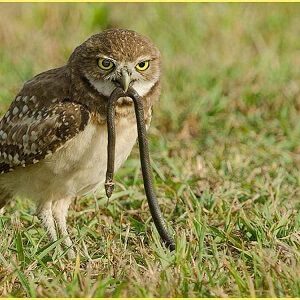 The great horned owl, Bubo virginianus, is an aggressive, powerful hunter, sometimes called the “tiger owl”. It is found in almost all habitats and will prey on any native snake it finds, provided the snake is small enough.
The great horned owl, Bubo virginianus, is an aggressive, powerful hunter, sometimes called the “tiger owl”. It is found in almost all habitats and will prey on any native snake it finds, provided the snake is small enough.
Western and Eastern Screech Owl
East screech owl, Megascops asio, is a small resident of the forest who eats any suitably sized prey it finds at night. It will look for common forest snakes in forest and suburban areas, like the rat snake.
The barred owl, Strix Varia, is a medium-sized bird with distinctive horizontal lines on the chest and vertical lines on the belly. Its favorite prey includes mice, but it will also prey on snakes such as the eastern ribbon and rat snake. Barred owls live in wet forests, wooded swamps, and forests near rivers and streams.
Burrowing owl
The burrowing owl, Athene cunicularia, is a small bird that nests on the ground, often in dens already dug by other animals, such as coyotes. Its main prey is large insects such as cockroaches and locusts, but will also prey on small mammals, birds, scorpions, and small snakes. The burrowing owl is found in open, dry meadows, on the land, and in deserts.
Other creatures that eat snakes
Snakes appear to be powerful poisonous animals that suggest fear to many, but there are species that eat them.
- Prey birds
- Crocodiles
- Wild pigs and warthog
- Representatives of the feline family
- Varan
- Other animals (depending on the habitat of a particular individual).
Raccoons, mongooses, foxes, coyotes, warthogs, birds, and other snakes eat snakes on a regular basis. Snakes have a variety of predators, which vary depending on their size and location. Snake eggs and young snakes are prey more than adults, although there are animals that hunt adult snakes.
Prey birds are one of the snake’s most prominent predators. Birds have a harsh vision that allows them to see the snakes on land, in trees, or even in water. Birds are able to fly unexpectedly, plucking snakes with their sharp claws and then taking them to an ideal feeding area.
Kingsnake hunts actively many types of snakes, and some other snakes have been known as cannibals.
Large snakes are often eaten by wild pigs, although they tend to avoid hunting venomous snakes. Wild pigs are very powerful and often hunt in packs, making them highly effective even for the largest snakes.
Raccoons and foxes are able to climb trees to hunt snakes and can also run fast to catch the prey that escaped.
The hedgehog tactic is to be provocative with the snake. As the snake continually attacks it trying to bite it, the hedgehog crouches in the form of a ball to defend its snout. The snake is exposed to the hedgehog’s needles and because it is in pain, it starts attacking, again and again, thus entering into a rage of attacks, which quickly makes it tired and lose control. The hedgehog waits, and when it realizes that the snake is tired, gives a fatal bite in the head-body area. After that, the hedgehog eats the snake quietly.
It is well known that hedgehogs have resistance to serpentine poison. The hedgehog is very resistant to poisons, but usually, it does not eat the head with fangs, because it doesn’t want to get an additional dose of poison.
Conclusion
Owls occupy almost all habitats, from meadows and tundra to dense rainforests. The distribution and density of most species are mainly limited by the availability of suitable nesting sites, rather than the number of possible preys. The type of prey depends on the size of the owls that hunt by chasing the potential prey during flight, and then quickly falling into the grass and catching the animals, also including snakes.
